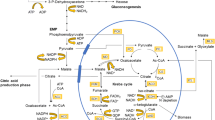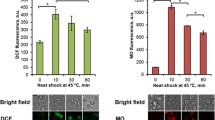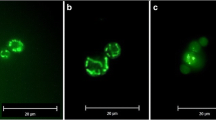Abstract
In this study we used tightly-coupled mitochondria from Yarrowia lipolytica and Dipodascus (Endomyces) magnusii yeasts. The two yeast strains are good alternatives to Saccharomyces cerevisiae, being aerobes containing well-structured mitochondria (thus ensuring less structural limitation to observe their appreciable swelling) and fully competent respiratory chain with three invariantly functioning energy conservation points, including Complex I, that can be involved in induction of the canonical Ca2+/Pi-dependent mitochondrial permeability transition (mPTP pore) with an increased open probability when electron flux increases (Fontaine et al. J Biol Chem 273:25734–25740, 1998; Bernardi et al. FEBS J 273:2077–2099, 2006). High-amplitude swelling and collapse of the membrane potential were used as parameters for demonstrating pore opening. Previously (Kovaleva et al. J Bioenerg Biomembr 41:239–249, 2009; Kovaleva et al. Biochemistry (Moscow) 75:297–303, 2010) we have shown that mitochondria from Y. lipolytica and D. magnusii were very resistant to the Ca2+ overload combined with varying concentrations of Pi, palmitic acid, SH-reagents, carboxyatractyloside (an inhibitor of ADP/ATP translocator), as well as depletion of intramitochondrial adenine nucleotide pools, deenergization of mitochondria, and shifting to acidic pH values in the presence of high [Pi]. Here we subjected yeast mitochondria to other conditions known to induce an mPTP in animal and plant mitochondria, namely to Ca2+ overload under hypoxic conditions (anaerobiosis). We were unable to observe Ca2+-induced high permeability of the inner membrane of D. magnusii and Y. lipolytica yeast mitochondria under anaerobic conditions, thus suggesting that an mPTP-like pore, if it ever occurs in yeast mitochondria, is not coupled with the Ca2+ uptake. The results provide the first demonstration of ATP-dependent energization of yeast mitochondria under conditions of anaerobiosis.
Similar content being viewed by others
References
Åkerman KE, Wikström MK (1976) FEBS Lett 68(2):191–197
Andreishcheva EN, Soares MIM, Zvyagilskaya RA (1997) Russian J Plant Physiol 44:657–664
Bazhenova EN, Votyakova TV, Zvyagilskaya RA (1989) Doklady Acad Sci 309(2):481–483
Bazhenova EN, Deryabina YI, Eriksson O, Zvyagilskaya RA, Saris N-EL (1998a) J Biol Chem 273:4372–4377
Bazhenova EN, Saris N-EL, Zvyagilskaya RA (1998b) Biochim Biophys Acta 1371:96–100
Bernardi P (1999) Physiol Rev 79(4):1127–1155
Bernardi P, Scorrano L, Colonna R, Petronilli V, Di Lisa F (1999) Eur J Biochem 264(3):687–701
Bernardi P, Krauskopf A, Basso E, Petronilli V, Blachly-Dyson E, Di Lisa F, Forte MA (2006) FEBS J 273(10):2077–2099
Bradford MM (1976) Anal Biochem 72:248–254
Burbaev DSh, Blumenfeld LA, Zvyagilskaya RA (1983) Biofizika 28(2):292–297
Castrejon V, Pena A, Uribe S (2002) J Bioenerg Biomembr 34:299–306
Chance B, Williams GR, Holmes WF, Higgins J (1955) J Biol Chem 217(1):439–451
Chávez E, Meléndez E, Zazueta C, Reyes-Vivas H, Perales SG (1997) Biochem Mol Biol Int 41(5):961–968
Colin J, Garibal J, Mignotte B, Guenal I (2009) Biochem Biophys Res Commun 379(4):939–943
Crompton M (1999) Biochem J 341(Pt 2):233–249
Cymerman IA, Chung I, Beckmann BM, Bujnicki JM, Meiss G (2008) Nucleic Acids Res 36(4):1369–1379
Deryabina YI, Zvyagilskaya RA (2000) Biochemistry (Moscow) 65(12):1352–1356
Deryabina YI, Bazhenova EN, Saris NE, Zvyagilskaya RA (2001) J Biol Chem 276(51):47801–47806
Deryabina YI, Isakova EP, Shurubor EI, Zvyagilskaya RA (2004) Biochemistry (Moscow) 69(9):1025–1033
Di Lisa E, Bernardi P (1998) Mol Cell Biochem 184(1–2):379–391
Eisenberg T, Buttner S, Kroemer G (2007) Apoptosis 12(5):1011–1023
Fontaine E, Ichas F, Bernardi P (1998) J Biol Chem 273(40):25734–25740
Guerin B, Bunoust O, Rouqueys V, Rigoulet M (1994) J Biol Chem 269(41):25406–25410
Gutierrez-Aguilar M, Perez-Vazquez V, Bunoust O, Manon S, Rigoulet M, Uribe S (2007) Biochim Biophys Acta 1767(10):1245–1251
Halestrap AP (2009) J Mol Cardiol 46(6):821–831
Holman JD, Hand SC (2009) J Exp Mar Bio Ecol 376(2):85–93
Kovaleva MV, Sukhanova EI, Trendeleva TA, Zyl'kova MV, Ural'skaya LA, Popova KM, Saris NE, Zvyagilskaya RA (2009) J Bioenerg Biomembr 41(3):239–249
Kovaleva MV, Sukhanova EI, Trendeleva TA, Popova KM, Zylkova MV, Uralskaya LA, Zvyagilskaya RA (2010) Biochemistry (Moscow) 75(3):297–303
Krasnikov BF, Kuzminova AE, Zorov DB (1997) FEBS Lett 419(1):137–140
Kuzminova AE, Zhuravlyova AV, Vyssokikh MYu, Zorova LD, Krasnikov BF, Zorov DB (1998) FEBS Lett 434(3):313–316
Lucken-Ardjomande S, Montessuit S, Martinou JC (2008) Cell Death Differ 15(5):929–937
Madeo F, Frolich E, Frohlich KU (1997) J Cell Biol 139(3):729–734
Manon S, Guerin M (1997) Biochim Biophys Acta 1318(3):317–321
Manon S, Guerin M (1998) Biochem Mol Biol Int 44(3):565–575
Manon S, Roucou X, Guerin M, Rigoulet M, Guerin M (1998) J Bioenerg Biomembr 30(5):419–429
Menze MA, Hutchinson K, Laborde SM, Hand SC (2005) Am J Physiol Regul Integr Comp Physiol 289(1):R68–76
Perez-Vazquez V, Saavedra-Molina A, Uribe S (2003) J Bioenerg Biomembr 35(3):231–241
Prieto S, Bouillaud F, Ricquier D, Rial E (1992) Eur J Biochem 208(2):487–491
Prieto S, Bouillaud F, Rial E (1995) Biochem J 307(Pt 3):657–661
Prieto S, Bouillaud F, Rial E (1996) Arch Biochem Biophys 334(1):43–49
Roucou X, Manon S, Guerin M (1997) Biochem Mol Biol Int 43(1):53–61
Smardova J, Smarda J, Koptikova J (2005) Differention 73(6):261–277
Suleiman MS, Halestrap AP, Griffiths EJ (2001) Pharmacol Ther 89(1):29–46
Virolainen E, Blokhina O, Fagerstedt K (2002) Ann Bot 90(4):509–516
Votyakova TV, Bazhenova EN, Zvyagil'skaya RA (1990) FEBS Lett 261(1):139–141
Votyakova TV, Bazhenova EN, Zvyagil’skaya RA (1992) Biol Membrany 9:341–348
Zoratti M, Szabò I (1995) Biochim Biophys Acta 1241(2):139–176
Zvyagilskaya RA, Zelenshichikova VA, Uralskaya LA, Kotelnikova AV (1981) Biochemistry (Moscow) 46(1):3–10
Zvyagilskaya RA, Leykin YuN, Kozhokaru NL, Kotelnikova AV (1983) Doklady Acad Sci 269(5):1238–1240
Zvyagilskaya RA, Perlova NN, Stepanov SV, Burbaev DSh, Uralskaya LA, Kotelnikova AV (1988) Biochemistry (Moscow) 53(1):101–106
Zvyagilskaya R, Andreishcheva E, Soares IMI, Khozin I, Berhe A, Persson BL (2001) J Basic Microbiol 41(5):283–303
Author information
Authors and Affiliations
Corresponding author
Rights and permissions
About this article
Cite this article
Trendeleva, T., Sukhanova, E., Ural’skaya, L. et al. Mitochondria from Dipodascus (Endomyces) magnusii and Yarrowia lipolytica yeasts did not undergo a Ca2+-dependent permeability transition even under anaerobic conditions. J Bioenerg Biomembr 43, 623–631 (2011). https://doi.org/10.1007/s10863-011-9402-3
Received:
Accepted:
Published:
Issue Date:
DOI: https://doi.org/10.1007/s10863-011-9402-3




